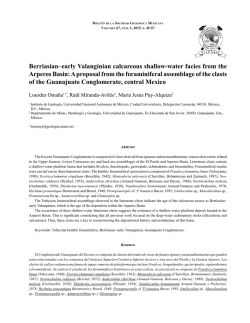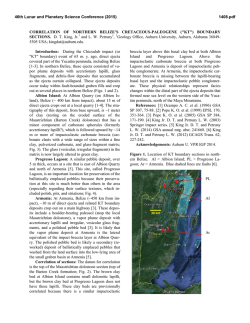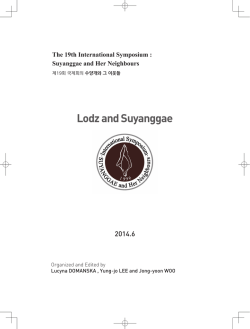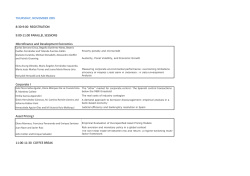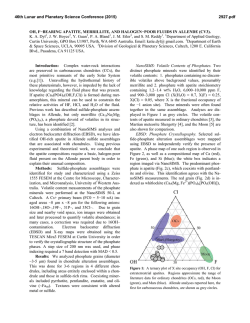
Benthic foraminifera as bioindicators of - ResearchGate
Revista Mexicana de Ciencias Geológicas, 29, núm. 3, as 2012, p. 527-533of anthropogenic impacts Benthic v. foraminifera bioindicators 527 Benthic foraminifera as bioindicators of anthropogenic impacts in two north African lagoons: a comparison with ostracod assemblages Francisco Ruiz1,*, María Luz González-Regalado1, Emilio Galán2, María Isabel González2, María Isabel Prudencio3, María Isabel Dias3, Manuel Abad1, Antonio Toscano1, José Prenda4, and Edith Xio Mara García5 2 1 Departamento de Geodinámica y Paleontología, Universidad de Huelva, 21071-Huelva, Spain. Departamento de Cristalografía, Mineralogía y Química Agrícola, Universidad de Sevilla, 41071-Huelva, Spain. 3 Instituto Tecnológico e Nuclear, EN-10, 2686-953-Sacavém, Portugal. 4 Departamento de Biología Ambiental y Salud Pública, Universidad de Huelva, 21071-Huelva, Spain. 5 Departamento de Botánica y Zoología, Universidad de Guadalajara, 45510-México. *[email protected] ABSTRACT Numerous investigations have used the foraminiferal assemblages or species as bioindicators. This paper tests the responses of these microorganisms to different environmental changes (heavy metal pollution, treatment stations, artificial inlets, agricultural and urban sewages) and compares them to those observed previously on ostracod assemblages. Foraminifera are more tolerant to these changes, while ostracods present a more specialized response. Key words: foraminifera, Ostracoda, bioindicators, lagoons, north Africa. RESUMEN Numerosas investigaciones han utilizado a las asociaciones o especies de foraminíferos como bioindicadores. Este trabajo investiga la respuesta de estos microorganismos ante diferentes cambios ambientales (contaminación por metales pesados, estaciones de tratamiento de residuos, pasajes artificiales, desechos urbanos e industriales) y la compara con la observada previamente en las asociaciones de ostrácodos. Los foraminíferos son más tolerantes a estos cambios, en tanto que la respuesta de los ostrácodos es más especializada. Palabras clave: foraminíferos, ostrácodos, bioindicadores, lagunas, norte de África. Ruiz, F., González-Regalado, M.L., Galán, E., González, M.I., Prudencio, M.I., Dias, M.I., Abad, M., Toscano, A., Prenda, J., García, E.X.M., 2012, Benthic foraminifera as bioindicators of anthropogenic impacts in two north African lagoons: a comparison with ostracod assemblages: Revista Mexicana de Ciencias Geológicas, v. 29, núm. 3, p. 527-533. 528 Ruiz et al. INTRODUCTION Coastal lagoons are included among the most fragile ecosystems in the world, with an increasing pressure derived from anthropogenic inputs such as agricultural sewages, industrial wastes, mining activities or urban effluents during the last century (Prudêncio et al., 2007). These ecosystems are widely distributed along the peri-Mediterranean coasts, covering approximately 660,000 ha at present (Trabelsi et al., 2004). The COLASU Project is a Research and Technology (RTD) Project sponsored by the European Union un- der the 5th Framework -International Cooperation with Mediterranean Partner Countries (INCO-Med)- Programme. This project concerns two lagoonal ecosystems of Morocco (Nador lagoon) and Tunisia (El Meleh lagoon). Both lagoons are subjected to different environmental impacts derived from public treatment stations, mining activities, agricultural residues or industrial wastes (Figure 1). Foraminifera are usually included between the most promising (palaeo-)environmental bioindicators in recent and Holocene coastal areas (e.g. Laprida et al., 2011; Santa Rosa-del Río et al., 2011). Effects of anthropogenic impacts on foraminiferal assemblages have been widely studied a) b) km Figure 1. Location of the study areas including the main environmental impacts and sampling stations. a) Nador lagoon (Morocco); b) El Melah lagoon (Tunisia). Benthic foraminifera as bioindicators of anthropogenic impacts (see Alve, 1995; Yanko et al., 1999; Armynot du Châtelet and Debenay, 2010; or Frontalini and Coccioni, 2011 for a general overview). In addition, changes on foraminiferal diversity, density or assemblages and even morphological abnormalities have been observed in different lagoons with heavy metal pollution or eutrophication (e.g. Luciani, 2007; Buosi et al., 2010). The aim of this study is to describe the impacts of anthropogenic inputs on foraminiferal communities, waters and sediments in both Nador and El Melah lagoons. Foraminiferal response to environmental stress is compared with the response of ostracod populations in order to determine the effectiveness of both groups as environmental proxies. STUDY AREA Nador lagoon (Morocco) The Nador lagoon is the second largest lagoon complex of northern Africa (115 km2) and the broadest paralic environment of Morocco. This lagoon is protected by a NW-SE elongated spit (25 km length), only interrupted by an artificial inlet limited by two jetties that comunicates it with the Mediterranean Sea (Figure 1a). Most of the areas present water depths between 3 and 7 m, with an internal hydrodynamics dominated by the marine waters passing through the artificial inlet. Tidal regime is microtidal (0.35 m) and semidiurnal (Brethes and Tesson, 1978). Salinity range is typical of marine waters (38-40.9 mg/L), with the low salinity values and high nutrient concentrations near the public treatment station of Nador (Figure 1a; Ruiz et al., 2006b). Dissolved oxygen contents are very variable (3.9–10.5 ml/L), with the highest values in the artificial inlet (González-Regalado et al., 2005). This lagoon is subjected to an increasing anthropogenic pressure owing to the economic activities in the adjacent areas: a) an old iron mine (Figure 1a: sample N1) which caused a strong heavy metal pollution in the bottom sediments of the lagoon (Ruiz et al, 2006a); b) the artificial inlet causes salinity changes in the adjacent areas (sample N2); c) the public treatment station of Nador (sample N3) become insufficient due to the expansion of this region and only provides partial biological treatment, without any additional physicochemical purification, microbiological control, or disinfection; and d) some villages (Figure 1a: Kariet Arkmane; sample N4) drain their fecal waters directly into the lagoon whitout any previous treatment. El Melah lagoon (Tunisia) The small El Melah lagoon (200 ha) is located near the town of Slimene (NE Tunisia). This lagoon presents an artificial connection (8 m long) with the Gulf of Tunis, 529 crossing a littoral dune strand (Figure 1b). Four main geomorphologic units may be distinguished: a) the littoral dune strand; b) El Melah Lagoon, with permanent waters and vegetated bottom (Ruppia, Zostera and Enteromorpha); c) the littoral plain, formed by old dunes and marshes; and d) the consolidated dune strand of Slimene. Saliniy ranges from 5.9 to 36 g/L, with the lowest values being located near the waste treatment station of Slimene (Fig. 1b). Waters are mostly alkaline (pH 7.8–8.5), although the eastern corner presents acidic values (pH 6.3–6.8) due to the bacterial decay of an algal cover and the low tidal renewal (Ruiz et al., 2006a). Several anthropogenic inputs cause important environmental changes: a) the artificial inlet induces the entry of seawater (salinity: 34–36 g/L) into the lagoon and the transport of marine, medium sands to the sea channel (Figure 1b: sample E1); b) the waste streatment station of Slimene drains directly to the western, confined area of the permanent lagoon waters, with important salinity changes (even 5.9 g/L) and eutrophication processes (sample E2); c) some old, abandoned saltworks (sample E3) are located in the central lagoon; and d) different agricultural sewages and urban residues are observed in the innermost areas of the lagoon (sample E4) MATERIAL AND METHODS Four sites were selected from each lagoon to test the impact of different anthropogenic inputs (Figure 1) on the foraminiferal populations. In each site, three duplicated subsamples were obtained for water, sediment and microfaunal analyses. Water sub-samples were subjected to the following procedures in the Surface Geochemical Centre (Strasbourg, France): analysis of some physical–chemical parameters (salinity and pH); ion chromatography (Dionex) for nitrites, phosphates, and sulfates; and colorimetry for ammonium. Results are expressed in mg/L (Table 1a). Sediments were collected manually from the upper 2 cm and wet sieved in order to establish the grain-size distribution. Six trace elements were determined (Table 1b) on the < 2 μm fraction using neutron activation analysis (Cd, Cu, Mn, Pb, Zn) and inductively coupled plasma-optical emission spectrometry (As). Additional sub-samples were selected for the analysis of the foraminiferal record present in this upper layer (Table 1c). In each sample, 100 g (dry weight) were slowly passed through a 63 μm sieve. The samples were stained with Rose Bengal in order to recognize the live individuals. Up to 300 individuals were picked in the final residues, if possible. More than 2700 specimens were studied to determine the percentages of the different species. Finally, both density (number of individuals per gram) and diversity (number of species) of each sample were calculated. Biocoenosis was very scarce in all samples (<5 % of 530 Ruiz et al. the total assemblage). Consequently, the use of total assemblage (live plus dead specimens) was preferred as an indicator of average environmental conditions for documenting of the foraminiferal response to anthropogenic inputs (e.g., Armynot du Châtelet et al., 2004). Results were compared with the ostracod assemblages obtained by Ruiz et al. (2006a, 2006b) following the same procedure in the same samples. RESULTS AND DISCUSSION Environmental inputs vs. foraminiferal response Foraminiferal assemblages show variable responses to different anthropogenic related activities. In the Nador lagoon, the most extreme of them was observed in highly polluted sediments by heavy metals collected near an old iron mine (Table 1c: sample N1; Zn > 1000 mg/kg; Pb, Cu > 400 mg/kg). In this zone, this assemblage is composed exclusively of live and dead individuals of Nonion depressulum (Walker & Jacob, 1798). This species is a bioindicator species of metal pollution in salt lakes of Turkey (Barut et al., 2007) and presents a significant statistical correlation with some metal contents (e.g., Mn) in the Gulf of Izmir (Mediterranean Sea; Bergin et al., 2006). Effects of artificial inlets (samples N2 and E1) are linked to the domain of marine conditions (Table 1a), with salinities up to 35 g/L and coarser grain sizes in both lagoons. Under these conditions, shallow marine assemblages of miliolids (Quiqueloculina spp, Sinuloculina spp., Triloculina spp.) are dominant over lagoon species (N. depressulum, Ammonia tepida (Cushman, 1926)). Diversity is clearly lower near the artificial jetties of Nador lagoon (four species), a very unstable area owing to the dredging of the bottom sediments and the permanent traffic of fishing boats in relation to the quieter artificial inlet of El Melah lagoon (Table 1c: 36 species). This hydrodynamic stress is an unfavourable factor for the development of these microorganisms (Ruiz et al., 2004). A high percentage of miliolids show evidences of transport (fractures, loss of the last chamber), which confirms the unstability of this area. Wastes derived from treatment stations cause different response in both lagoons. Nutrient contents increase slightly near the Nador treatment station (Table 1a: sample N3), with the presence of a relatively diverse assemblage (11 species) and high foraminiferal densities (Table 1c: 144 individuals/ gr; biocoenosis: 4.5 %). These variations were observed, to a lesser extent, in some old saltworks of El Melah lagoon (sample E3), with very high phosphate contents. A small increase in nutrients can be beneficial for foraminifera, although a high nutrification may have negative effects on them (Osawa et al., 2010). Low salinities measured near the treatment station of El Melah lagoon (sample E2: 12.4 g/L) are caused by the continuous freshwater inputs of this station. The main effect is a marked decrease in the foraminiferal diversity and the dominance of brackish species (e.g., Haynesina germanica (Ehrenberg, 1840)). Consequently, dilution by fresh water causes a strong disturbance on the foraminiferal associations, as noted in other semi-arid lagoons (Hariri, 2008). The eastern borders of both lagoons (samples N4 and E4) present foraminiferal assemblages similar to those observed in subtidal sediments (e.g., samples N2-N3 or E3), but density varies markedly. In Nador lagoon, small agricultural wastes and urban sewages do not harm significantly benthic foraminifera, as pointed Samir (2000) in different lagoons of Egypt. Nevertheless, the density of E4 (El Melah lagoon) is much lower, coinciding with low oxygen contents, an algal covert and a low tidal renewal. Foraminifera vs. Ostracoda as environmental tracers: An approach A comparison of these results with those obtained by Ruiz et al. (2006a, 2006b) in the study of the ostracod assemblages of the same samples allows outlining the usefulness of both groups as environmental indicators. a) Heavy metal pollution. High levels of trace metals cause the disappearance of ostracods and the exclusive presence of tolerant species of foraminifera, a response observed in other areas subjected to acid mine drainage processes and recent industrial pollution (Ruiz et al., 2008). In addition, our data confirms the role of Nonion depressulum to bioindicator of stressing conditions (State University System of Florida, 1977). b) Hydrodynamic changes: artificial inlets. The natural evolution of these semi-arid lagoons involves a natural process of closure, with a final transition to a sabkha scenario. Artificial inlets cause the introduction of both marine sediments and species into the lagoons and a partial erosion of the adjacent bottom areas due to the channeling of the tidal currents. These conditions are unfavourable for both foraminifera and ostracods (e.g., Wilson et al., 2008), only represented by transported specimens of marine or brackish species. c) Eutrophication. The main effect of the Nador waste treatment station is the presence of low O2 dissolved contents (3.9 mg/L) in the adjacent areas, owing to the organic matter consumption (Inani, 1995). Foraminiferal assemblages are dominated by stress-tolerant genera (Ammonia, Nonion), whereas a high proportion of the ostracod faunas are represented by opportunistic species (mainly loxoconchids) tolerant to hypoxic conditions (Alvarez-Zarikian et al., 2000). d) Fresh water inputs. Salinity is a major factor regulating ostracod community structure and the response of these crustaceans is the appearance of stenohaline species limited to freshwater to low brackish wa- 531 Benthic foraminifera as bioindicators of anthropogenic impacts Table 1. a) Physical-chemical parameters and nutrients in waters of Nador lagoon (samples N-) and El Melah lagoon (samples E-); b) Grain size and heavy metal contents in bottom sediments of both lagoons; c) Percentages, diversity and density of foraminifera. nd: no data. A. WATER Nutrients Chemistry SAMPLES Salinity (g/L) pH Nitrites (mg/L) Phosphates (mg/L) Sulphates (mg/L) Ammonium (mg/L) B. SEDIMENT Heavy metals (mg/ kg) N2 N3 N4 E1 E2 E3 E4 38.7 38.1 37.3 40.1 35.9 12.4 31.4 29 8.2 8.4 8.1 8.3 7.4 6.8 0.045 0.06 692 0.009 0.05 0.3 610 0.013 0.06 1.99 357 0.36 0.045 0.3 667 0.01 8.19 Grain size C. FORAMINIFERA N1 As Cd Cu Mn Pb Zn Acervulina inhaerens Ammonia ammoniformis Ammonia beccarii Ammonia sobrina Ammonia tepida Amphisours hemprichi Bolivina striatula Cymbaloporetta squamosa Elphidium aculeatum Elphidium advenum Elphidium complanatum Elphidium crispum Elphidium excavatum Elphidium macellum Elphidium williamsonii Eponides repandus Globulina gibba Guttulina lactea Haynesina germanica Lobatula lobatula Martinotiella communis Neoconorbina terquemi Nonion depressulum Nonionella atlantica Nubecularia massutiniana Peneroplis pertusus Peneroplis planatus Planorbulina mediterranea Porosononion granosum Quinqueloculina carinata Quinqueloculina laevigata Quinqueloculina longirostra Quinqueloculina oblonga Quinqueloculina seminulum Quinqueloculina vulgaris 8.24 0.003 0.002 1522 0.001 0.003 0.001 1507 0.001 0.008 0.004 1493 0.048 0.002 0.003 1584 0.001 Silty clay Fine sand Clay Clay 9.9 nd 43 607 33 90 15 0.9 94 743 67 172 6 4.42 23.52 25.82 84.5 6.2 466 5141 416 1190 nd 29 316 25 83 33.81 9.18 0.17 0.68 0.66 Silty sand Silty clay 6.6 4.5 5 145 0.5 14 12.45 1.25 0.49 0.75 0.49 0.49 0.75 0.26 7.36 1.29 0.75 0.75 3.3 0.26 0.49 10.8 2.7 16 296 0.3 66 31.25 4.17 Silty clay Clay 12.3 0.6 29 261 6 101 5.5 0.9 24 211 12 40 23.11 17.07 13.94 27.24 5.18 32.93 2.39 64.58 1.78 1.2 4.14 100 17.79 1.29 0.26 5.58 1.02 0.49 2.05 1.02 0.26 11.55 23.9 15.04 2.39 6.88 5.84 46.92 1.72 2.87 6.3 6.2 36.57 1.29 4.32 5.98 0.81 continues 532 Ruiz et al. Table 1 (continued). C. FORAMINIFERA N1 Rosalina bradyi Sigmoilina costata Sinuloculina rotunda Spiroloculina depressa Triloculina gibba Triloculina oblonga Triloculina trigonula Trochammina inflata Species Individuals/gram N2 N3 34.51 N4 12.42 14.16 5.52 5.74 1 27 5 88 11 144 10 121 E1 E2 13.66 1.52 5.84 1.29 3.04 8.92 7.63 1.78 36 54 E3 E4 2.79 7.57 3 1 11 5 6.91 6 5 ter ranges (e.g., sample E2: Ilyocypris gibba (Ramdohr, 1808), Heteroris salina (Brady, 1868)). This impact was also noted on foraminiferal populations, but they are constituted mainly by euryhaline, sometimes opportunistic species (e.g., Haynesina germanica; Redois and Debenay, 1996). e) Small agricultural or urban sewages. Foraminifera do not show a specific response to these low-level environmental impacts, whereas both density and diversity of ostracods decrease. f) Low oxygen contents. The presence of low tidal renewal and a algar covert cause oxygen depletion, with low foraminiferal density and diversity. ACKNOWLEDGMENTS CONCLUSIONS Alvarez-Zarikian, C.A., Blackwelder, P L., Hood, T., Nelsen, T.A., Featherstone, C., 2000, Ostracods as indicators of natural and anthropogenically-induced changes in coastal marine environments, in Coasts at the Millennium, Proceedings of the 17th International Conference of The Coastal Society, Portland, OR USA: The Coastal Society, 896-905. Alve, E., 1995, Benthic foraminifera response to estuarine pollution: a review: Journal of Foraminiferal Research, 25, 190-203. Armynot du Châtelet, E., Debenay, J.P., 2010, Anthropogenic impact on the western French coast as revealed by foraminifera: a review: Revue de Micropaléontologie, 53, 129-137. Armynot du Châtelet, E., Debenay, J.P., Soulard, R., 2004, Foraminiferal proxies for pollution monitoring in moderately polluted harbours: Environmental Pollution, 127, 27-40. Barut, I.F., Meric, E., Avsar, N., Unlu, V.S., 2007, Factor determining the distribution of benthic foraminiferal assemblages in the Saltpan and Salt Lakes of Gulf of Saros: Geophysical Research Abstracts, 9, 08556. Bergin, F., Kucuksezgin, F., Uluturhan, E., Barut, I.F., Meric, E., Avsar, N., Nazik, A., 2006, The response of benthic foraminifera and ostracoda to heavy metal pollution in Gulf of Izmir (Eastern Aegean Sea): Estuarine, Coastal and Shelf Science, 66, 368-386. Brady, G. S., 1868, Ostracoda, in, De Folin, Perier (eds.), Les Fonds de la Mer, De Folian et Perier, Paris, pp.54-59. Brethes, J.C., Tesson, M., 1978, Observations hydrologiques sur la Sebkha Bou Areg (la lagune de Nador, Maroc). Bilan d’automne 76 and d’hiver 77: Bulletin de l’Institute Supérieur des pêches maritimes du Maroc, 24, 1-16. Buosi, C., Frontalini, F., Da Pelo, S., Chechi, A., Coccioni, R., Bucci, C., 2010, Foraminiferal proxies for environmental monitoring The database of anthropogenic inputs provided by the COLASU project permits to establish the utility of benthic foraminifera as bioindicators. Some genera are highly tolerant to eutrophication (e.g., Ammonia) or heavy metal pollution (e.g., Nonion). Salinity and hydrodynamic changes derived from artificial inlets cause the appearance of marine assemblages with variable density and diversity, whereas small agricultural/urban sewages do not affect significantly to these microorganisms. Ostracods show a different response, with a disappearance under high pollution conditions, the presence of opportunistic, low-oxygen tolerant species in eutrophic areas or stronger changes of associations linked to salinity variations (inlets, treatment stations). Therefore, it is possible to establish an approximation of the degree of environmental impact of these changes for these lagoons: high heavy metal pollution (tolerant foraminifera/no ostracods) > eutrophication ~ hypoxic conditions (tolerant foraminifera/tolerant ostracods) > artificial inlets ~ dilution by fresh water (new assemblages) > low oxygen depletion > small agricultural/urban sewages (low ostracod diversity). This work was funded by a European Union Project (ICA3-CT-2002-10012-COLASU), an Andalusia Excellence Project (SEJ-4770) and a Research Group of the Andalusia Board (RNM-238). This paper is a contribution to the IGCP 588 (“Preparing for coastal change”). We thank Dr. R. Coccioni and Dr. M. S. Hariri for critical, helpful and constructive reviews of the manuscript. We also wish to thank the chief editor of the Revista Mexicana de Ciencias Geológicas for their assistance with the manuscript. REFERENCES Benthic foraminifera as bioindicators of anthropogenic impacts in the polluted lagoon of Santa Gilla (Cagliari, Italy): Present Environment and Sustainable Development, 4, 91-103. Cushman, J.A., 1926, Recent Foraminifera from Porto Rico: Carnegie Institution of Washington Publications, 344, 73-84. Ehrenberg, C.G., 1840, Über die Bildung der Kreidefelsen und des Kreidemergels durch unsichtbare Organismen: Physikalische Abhandlungen der Königlichen Akademie der Wissenschaften zu Berlin, separate 1839, 59-147. Frontalini, F., Coccioni, R., 2011, Benthic foraminifera as bioindicators of pollution: A review of Italian research over the last three decades: Revue de Micropaléontologie, 54, 115-127. González-Regalado, M.L., Ruiz, F., Abad, M., Hamoumi, N., Boumaggard, E.H., Bouamterhane, I., Guddari, F., Toumi, A., Dassy, K., Ben Ahmed, R., 2005, Distribución de los foraminíferos bentónicos en climas semiáridos: las lagunas de Nador (Marruecos) y El Meleh (Túnez): Geogaceta, 37, 211-214. Hariri, M.S.B., 2008, Effect of hydrographic conditions on the ecology of benthic foraminifera in two hipersaline lagoons, eastern Red Sea coast, Kingdom of Saudi Arabia. JKAU: Marine Sciences, 19, 3-13. Inani, I., 1995, Dynamique sédimentaire et état de la pollution dans la lagune de Nador: University of Rabat, Morocco, Ph.D. thesis, 199 pp. Laprida, C., Chandler, D.E.C., Mercau, J.R., López, R.A., Marcomini, S., 2011, Modern foraminifera from coastal settings in northern Argentina: implications for the paleoenvironmental interpretation of Mid Holocene littoral deposits: Revista Mexicana de Ciencias Geológicas, 28 (1), 45-64. Luciani, V., 2007, Test abnormalities in benthic foraminifera and heavy metal pollution at the Goro lagoon (Italy): a multi-year history: Geophysical Research Abstracts, 9, 09765. Osawa, Y., Fujita, K., Umezawa, Y., Kayanne, H., Ide, Y., Nagoaka, T., Miyajima, T., Yamano, H., 2010, Human impacts on large benthic foraminifers near a densely populated aea of Majuro Atoll, Marshall Islands: Marine Pollution Bulletin, 60, 1279-1287. Prudêncio, M.I., Gonzales, M.I., Dias, M.I., Galán, E., Ruiz, F., 2007, Geochemistry of sediments from El Melah lagoon (NE Tunisia): a contribution for the evaluation of anthropogenic inputs: Journal of Arid Environments, 69, 285-298. Ramdohr, K.A., 1808, Über die Gattung Cypris Müll. und drei zu derselben gehörige neue Arten: Magazin der Gesellschaft naturforschender Freunde zu Berlin für die neuesten Entdeckungen in der gesammten Naturkunde, 2, 82-93 Redois, F., Debenay, J.P., 1996, Influence of confinement sur la répartition des foraminferes bentiques: example de l’estran d’une ria mésotidale de Bretagne Méridionales: Revue de Paléobiologie, 15, 243-260. 533 Ruiz, F., González-Regalado, M.L., Borrego, J., Abad, M., Pendón, J.G., 2004, Ostracoda and foraminifera as short-term tracers of environmental changes in very polluted areas: the Odiel Estuary (SW Spain): Environmental Pollution, 129, 49-61. Ruiz, F., Abad, M., Galán, E., González, I., Aguilá, I., Olías, M., Gómez Ariza, J.L., Cantano M., 2006a, The present environmental scenario of El Melah Lagoon (NE Tunisia) and its evolution to a future sabkha: Journal of African Earth Sciences, 44, 289-302. Ruiz, F., Abad, M., Olías, M., Galán, E., González, I., Aguilá, E., Hamoumi, N., Pulido, I., Cantano, M, 2006b, The present environmental scenario of the Nador Lagoon (Morocco): Environmental Research, 102, 215-229. Ruiz, F., Borrego, J., González-Regalado, M.L., López-González, N., Carro, B., Abad, M., 2008, Impact of millenial mining activities on sediments and microfauna of the Tinto River estuary (SW Spain): Marine Pollution Bulletin, 56, 1258-1264. Samir, A.M., 2000, The response of benthic foraminifera and ostracods to various pollution source: a study from two lagoons in Egypt: Journal of Foraminiferal Research, 30, 83-98. Santa Rosa-del Río, M.A., Ávila, G.E., Téllez-Duarte, M.A., GonzálezYajimovich, O., Cupul, L.A., 2011, Distribución y abundancia de tanatocenosis de foraminíferos bentónicos submareales en el delta del río Colorado: Boletín de la Sociedad Geológica Mexicana, 63, 445-458. State University System of Florida, 1977, Baseline monitoring studies, Mississippi, Alabama, Florida outer shelf, 1975-1976. BLM Contract 08550-CT5-30. Trabelsi, M., Maamouri, F., Quignard, J.P., Boussaïd, M., Faure, E., 2004, Morphometric or morpho-anatomal and genetic investigations highlight allopatric speciation in Western Mediterranean lagoons with the Atherina lagunae species (Teleostei, Atherinidae). Estuarine, Coastal and Shelf Science, 61, 713-723. Wilson, B., Miller, K., Thomas, A.L., Cooke, N., Ramsingh, R., 2008, Foraminifera in the mangal at the Caroni swamp, Trinidad: diversity, population structure and relation to sea level: Journal of Foramiferal Research, 38, 127-136. Yanko, V., Arnold, A.J., Parker,W.C., 1999, Effects of marine pollution on benthic Foraminifera, in Sen Gupta, B.K. (ed.), Modern Foraminifera. Kluwer Academic Publisher, Dordrecht, pp. 217–35. Manuscript received: January 20, 2012 Corrected manuscript received: May 1, 2012 Manuscript accepted: May 16, 2012
© Copyright 2025
